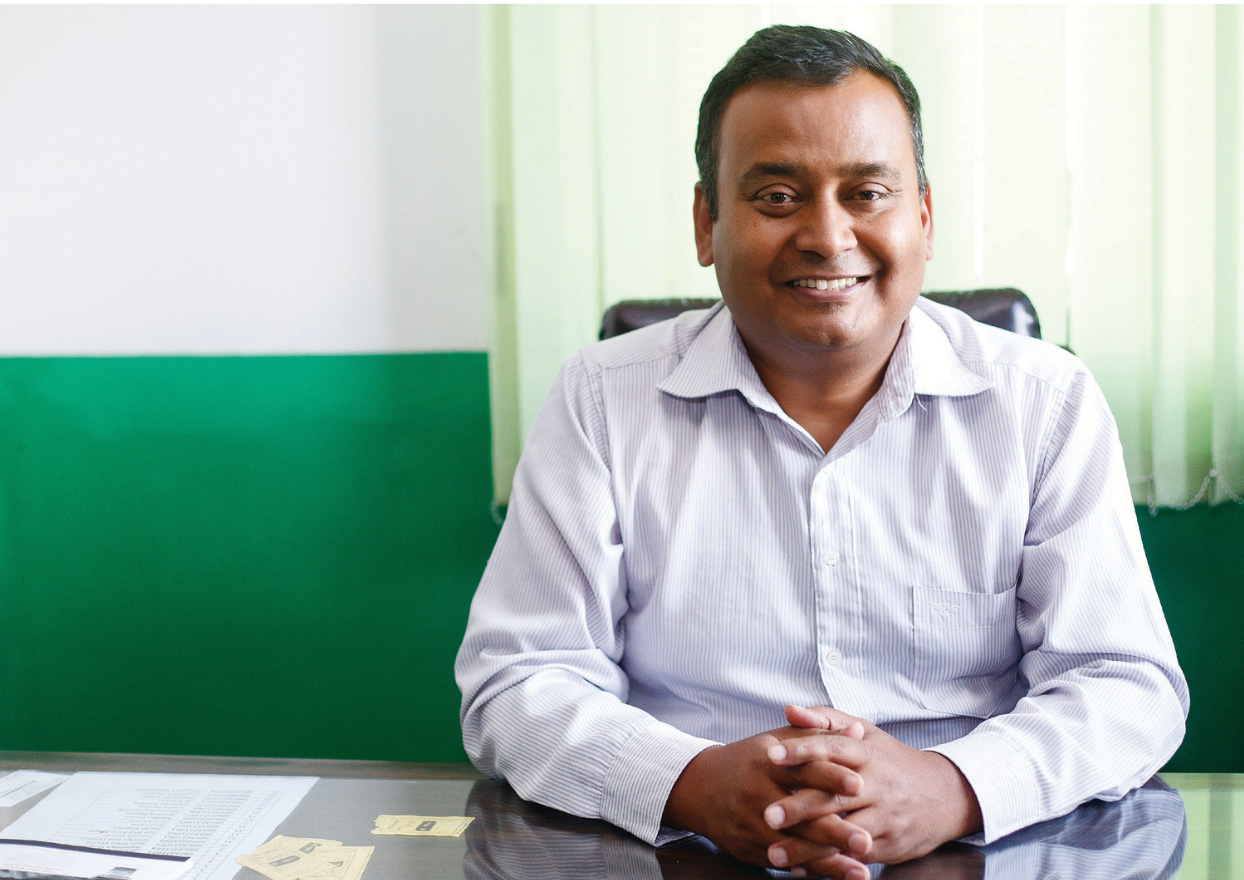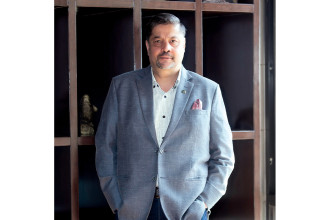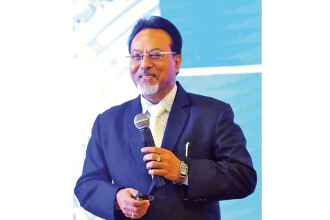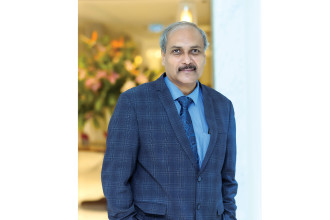
Bhushan Tuladhar is an environmental engineer and the Executive Director of Sajha Yatayat, a public transport cooperative organisation operating buses in and around Kathmandu. He obtained his BS and MEng degree in Civil and Environmental Engineering from Cornell University. “I chose environmental engineering because I was drawn more to the human side or social science as it is about dealing with people and nature. When I got into it, I started to enjoy everything about it and I felt there is a need for more people in this sector,” says Tuladhar. Before that, he did his IB in Liberal Arts from United World College of the American West. Tuladhar came back to Nepal in 1993 but his decision to return met with a lot of raised eyebrows. “If I had stayed in the US, I would have done well there, but I have no regrets coming back. I felt that there is more need and opportunity to display my work here in Nepal,” he states.
In the initial days after his return to Nepal, he struggled a bit until he got into International Union for Conservation of Nature (IUCN). “During my tenure with IUCN, we worked closely with National Planning Commission (NPC) so it was great to be working with the government while being a part of an international organisation,” he shares.
In 1998, Tuladhar got a call from Keshav Sthapit who had just been elected the Mayor of Kathmandu Metropolitan City. Sthapit asked Tuladhar to work for him as his advisor. “While working for Keshav Sthapit, we asked him to form an environment department which I headed for awhile,” he recalls. Tuladhar was also member of City Planning Commission, a professional body working on long term planning keeping view of the environmental aspects. “Working in KMC and City Planning Commission gave me a reality check and I realised that such are the workplaces where policies meet people.”
Tuladhar then joined Clean Energy Nepal, an NGO, as the Executive Director. Later, he worked for UN-Habitat as Chief Technical Advisor for South Asia. He is still the Chairperson of Environment and Public Health Organisation and Clean Energy Nepal, as well as an adviser to the United Nations Human Settlements Programme (UN-Habitat).
In an interview with Dibesh Dangol of B360, Tuladhar talked about the pending 300 electric buses, having a single public transport management organisation for every city, and measures for sustainable urban planning. Excerpts:
Failure to deliver proper public transportation has led to public angst and increase in the use of private vehicles despite how expensive it can be. What is Sajha Yatayat doing to address this?
The main emphasis of Sajha Yatayat has been to improve the service quality so that people would prefer to commute by public vehicles rather than own a private vehicle. This should be the emphasis of other companies involved in public transportation too. The factors to be considered to improve and provide quality services are the hardware and software of public vehicle operating business. Hardware means the buses whereas software includes discipline and behaviour of drivers and conductors, installing new technical features such as easy payment options and providing easy access to all types of passengers. Even though we have been improving such factors, we have realised that whatever we have been doing isn’t enough and there is still a lot to do. Support of the government is also required to solve this matter. If the government gives public vehicles dedicated road space, like a lane or two, the buses will become more efficient. Then people will realise the efficiency of public transportation which might make them prefer public transportation. To regain public trust is all about offering services that meet their aspirations and creating a positive image of public transportation. Currently, in Nepal, people consider public transport for poor and blue-collar people only. Such mindset needs to change and people need to realise the necessity and importance of public transportation.
Sajha Yatayat is targeting to offer good quality electric buses featuring air conditioners and air suspensions soon. If you can enhance the experience and the image of public transport as a whole, it will create a positive impact. Public transportation system is about road networks also. To make a proper road network, we need the help of the government. There are many other players in the market and everybody should be connected while holding such discussions to provide effective and efficient services.
Two things can be done by the local government: regulate and invest in public transportation. Before, the local governments were reluctant to invest in public transportation. But now, along with Kathmandu and Lalitpur municipalities, others have also started to invest in Sajha Yatayat. Through such investments, we have been able to purchase our fleets. This is also encouraging for other public transport operators. If we hadn’t got the investment, we would have been shackled to compromise on the services. In terms of regulating public transportation, Kathmandu Metropolitan City came up with Transportation Act of its own which they are regulating but haven’t been able to implement effectively since there are a lot of players in this market. There is no proper clarity in terms of who is responsible to manage public transportation. So, if the local, provincial or central governments clarify such issues, it would be great and we, as in public transportation companies, can work with that particular agency or institution. Sajha Yatayat hasn’t got a lot of opportunities to work with privately owned public transportation companies, but some of them have bought and are operating big buses like Sajha Yatayat which is great to see.
What importance does public transportation play in the development of a city or country?
It plays a huge role. Proper functioning public transportation indicates two things: social equity and efficiency. Social equity means putting everybody on the same board. The streets and roads are for everybody and not just fancy cars or private vehicles. People from all backgrounds should be using public transportation. The former Mayor of Bogota, Enrique Penalosa once said, “An advanced city is not a place where the poor move about in cars, rather it’s where even the rich use public transportation.” It means that if we can get rich people to commute in public transportation, it is an indicator of social equity.
Secondly, public transportation is a country’s efficiency indicator. Most of the cars plying on the roads of Nepal have utmost 2-3 people and there are also many motorcycles with single riders, whereas 40-50 people can commute in a bus. The road space that private vehicles are currently taking is massive resulting in traffic congestion. The priority of every citizen should be to use road space efficiently, especially in a city like Kathmandu where there are limited spaces. It is also related to using vehicles efficiently. In a day, private vehicles are being used just for two hours on average. For two hours they are on the road providing service but for 22 hours it is occupying a public space i.e. parking lot, whereas buses operate 12-13 hours a day and are constantly on the move. People can get value for money in public transportation. If a city or a country has an efficient public transportation system, it contributes towards the economy and also the environment. Comparing to the per capita emission between a car or a motorcycle carrying two people and a bus carrying 40 people, a car or a motorcycle might emit less harmful emission than a bus individually. But, when calculated on a macro scale, the bus is more efficient from a social, economic and environmental perspective.
I don’t expect people to realise this because people have always prioritised their convenience first and have dramatically shifted to private vehicles. This has happened because concerned people, companies and government institutions involved in the public transportation sector haven’t been able to serve well and provide quality service. Public transportation is not a preferred option for everybody because of its tarnished image. Moreover, people have perceived private vehicles as status symbol. This perception needs to be changed. So, it is up to the government and society to bring up the image of public transportation, make it attractive and convenient for people.
Can you give us an update on the pending 300 electric buses?
The cabinet hasn’t rejected the project completely, but it has been on hold for more than two months and the work we had previously done is at standstill. We had completed pre-feasibility study, sold our shares to the government to allocate Rs 3 billion for 300 electric buses, formed a committee with representatives from Ministry of Physical Planning and Transport, Department of Transport Management, Kathmandu Metropolitan City, Nepal Electricity Authority, Sajha Yatayat and independent experts, and prepared a draft of specification document. We had already prepared to hold a board meeting to discuss the draft of the specification document, but a day before the meeting we got a letter from the government to halt the process.
We haven’t received the exact reason why the project has been halted although the government has said it in the media that the halt is because of the delay in project and changes made in the specification document provided by the government… which I don’t believe. If there was a delay, instead of halting the project, the government should have ordered us to speed up the processes of the project. Regarding changes made in the specification document, the initial documentation provided to us by the government was just a page and a half long and in the footnote, it was mentioned that it is just a framework. So, the document didn’t exactly specify anything to us which is why we took and made the document a base upon which we built and tweaked it a bit to create an improved version of the project. If you take that specification document to any technical expert, you’ll be told that such information isn’t enough. Though the government has said that the document isn’t correct, it should give us solutions rather than pointing fingers. We would appreciate if the government called us for a meeting and share the solution. We haven’t even shown our specification document to the government formally. That’s why we were about to call a board meeting so that we could discuss it. Without even looking at it, they said it’s not good. Even the representatives from the Ministry and Department of Transport who were in the committee weren’t consulted before taking such rash decision by the government which was a surprise for all of us. The longer the process is stopped, the longer the delay. The momentum has been broken within us too because the people involved in this project, who had been working for almost a month, haven’t met for more than two months now. More importantly, we need clear instructions from the government regarding the specifications of the buses that they want.
We have no idea when the process will resume and the buses will arrive. We have written to the government twice already and made daily phone calls but have got no response. We’ll have to wait and see. Our objective was to get the electric buses within this year but it will not be happening.
Few public transport management organisations have imbibed EV buses into their arsenal. How important is it for other transport management organisations to also have EV buses for cleaner cities in Nepal?
It’s very important. Sajha Yatayat alone cannot do it. But the others aren’t ready because they cannot afford electric buses right now. The government should come up with a financing system if it wants the country to imbibe electric vehicles. For example, everyone who uses petroleum pays Rs 0.50 per litre as pollution tax. In a year, more than a billion rupees are collected via this. If the government utilises that money, or a part of it, and says that it has a scheme in which any private sector wanting to invest in electric public buses are welcome, should meet such standards and will be provided with a subsidy, then suddenly operating electric buses becomes a viable business. Though the government has given tax subsidies for electric vehicles in Nepal, the financing subsidy will provide the added boost needed to fast-track public vehicles going electric.
Going electric has economic benefits also. The main deficit of our economy is led by petroleum import. If we can cut off that deficit by using electricity and electric products, which I think we have in abundance now, our economy will improve. If we don’t utilise our electricity properly, it will go to waste. Our electricity comes from the rivers and we can’t shut it off. Particularly, we have to use night-time electricity because the maximum amount of electricity goes to waste during night time. The best way to use it is through batteries. Batteries can be used to store electricity during the night and used during the day. So, from energy, economic, environment and social points of view, embedding electric vehicles and products have become important now more than ever before.
Constitutionally, provincial government along with local government should take charge of transport management. We have been working with Province 3 government, Kathmandu Metropolitan City and Lalitpur Metropolitan City, but for our electric buses project they haven’t been involved at all. So, the central government either needs to stay away from it and delegate responsibilities to provincial or local governments or should fast-track the process. It’s an unnecessary obstruction that’s been happening but it shouldn’t be happening regardless who is in charge of the project. Politics and development should never intertwine.
What are your thoughts on having a single public transport management organisation in every local government?
There are two ways to look at this. Firstly, there is a need for a single transport regulatory authority which determines the routes and regulates public transportation companies. We do have a transport management department but it is majorly active in publishing driving license and collecting vehicle taxes only. Dedicated public transport authority should be created to make detailed planning about the number of public buses required in every city and its routes. It should also be responsible for inviting the private sector to compete in providing services; not compete amongst themselves within a route, but compete for the route. For example: If they publish a notice regarding the need for 60 buses for Lagankhel to Budanilkantha route with such standards and at such prices, the private sector can openly come and bid for the route. If this is done, the government doesn’t need to provide the service by themselves and own the buses. In this way, the government will also get the private sector engaged in public transportation.
Secondly, the government can provide subsidy to public vehicle operators. In many foreign countries, the government provides a certain amount to public transport operating companies on certain kilometres so that the private sector doesn’t have to depend on what they collect from the passengers solely. That’s why they don’t even wait for passengers. This system will also assist in reducing traffic congestion and accidents, and increase public transport efficiency.
Is making a city ‘Smart’ all about installing smart technologies like parking, toilets and dustbins, or a mission which involves total urban planning and public awareness including environmental aspects? And do we have the resources to accomplish this?
There is a lot of debate on the concept of Smart City. People associate smart city with abundant use of technologies, which isn’t true. It’s more about using both techniques and technologies for efficient management of basic urban services like transportation, water, garbage, etc. Overall, the city should be efficient, meaning the output should be more than the input. The inputs can be capital, human force, resources, energy, etc and the output means the results. If people can grow more amounts of flowers using less amount of water, it is smart.
Similarly, the transportation system of any city needs to be made efficient so that it serves and benefits all citizens. In a city, you need a multi-model system in transportation. Some people need to ride bicycles, buses and private vehicles. A Smart City needs to be designed in such a way that each of these modes has a designated space to operate. People can choose the modes they want but the overall efficient modes should be prioritised like walking, cycling, etc, and there should be seamless transition amongst the modes. Using technology to make life convenient and city efficient is just an example of a Smart City, but we shouldn’t only depend on technology because technology can also become a barrier. The real meaning of a Smart City is integrating and managing the available resources with all aspects of city life. Making a city green isn’t similar to making a city smart. Green city is more concentrated on the environmental aspect and efficient utilisation of resources. But a Smart City needs to be green as well because cities bring people together and it’s where interactions happen.
We do have the resources to make our populated cities Smart Cities. Creating a smart city is all about planning and utilising the available resources properly and efficiently rather than making sudden drastic changes. The local, provincial and central governments should know these formulae and work on it by making long term urban planning projects mainly prioritising basic urban services like water, garbage and transportation. For a city to be smart, the general public needs to be smart!
In your past interviews, you have talked about the structural integrities that cities of Nepal used to have in the past, positive effects and importance of such structures, and how unplanned and rapid urbanisation destroyed the traditional system of water, land and resource management. Is it too late for Nepal to mend past mistakes?
I don’t think it’s too late and there is still a lot that can be done. Kathmandu was considered one of the best-planned cities of the world before rapid urbanisation hit Kathmandu and changed the landscape of the city drastically. Kathmandu was planned and designed in such a way that it was considered a Smart City until a few decades ago. The previous generation of people living in Kathmandu realised the limitation of resources and designed the city to maximise but preserve those resources. We don’t have to exactly go back to the structure that was 50 years ago, but the main thing is to understand the values and fuse those values with modern technologies. Fifty years ago, in 1969, when Kathmandu’s first urban planning was made, it was written that vehicles should be limited in the core city area of Kathmandu. Fifty years ago that was said and people didn’t follow which has caused drastic traffic congestions inside the core city area. We can still mend that mistake although a lot has been lost. One easy solution can be limiting vehicle entrances in such areas and running electric rickshaws.
In the book ‘The Newars’, which was written 50 years ago by Gopal Singh Nepali, it’s mentioned that Newars used to sell their waste for 50 paisa per tin box. What can we understand from this is that the people back then knew that waste had value, waste can be recycled and the person who generated the waste themselves took responsibility for waste management. I am not saying that we need to go back to that system completely, but we need to understand the principle values of waste management; waste has a value, can be recycled and people themselves should be responsible for their waste. If we completely forget these values, there is no way we can manage the waste, garbage and drainage problems that we are currently facing.
We need a modern system which follows these principles and methods. The Ministry of Urban Planning along with local governments should consider these principles and methods and make a modern system for proper and sustainable urban planning.
You have been advocating for clean mobility which includes the need for zero pollution vehicles, cycling lanes, road-side tree plantation, public transportation, promoting walking and conducting regular environment awareness campaigns. Do you think your voice is reaching the government?
It has been heard partially. The government has invested three billion rupees for electric buses, which I think is because of my advocacy. Recently, news regarding making the core city area of Kathmandu vehicle free/limited zone has also emerged which is great. It hasn’t happened exactly the way and in the rate I prefer, but we are slowly getting there. It is a long term process because people’s mindset and attitude should change. It’s almost like swimming upstream. So yes, there have been changes but it isn’t enough and a lot needs to be done.







